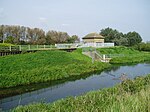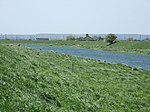Twenty railway station
1866 establishments in EnglandAll accuracy disputesDisused railway stations in LincolnshireFormer Midland and Great Northern Joint Railway stationsPages with no open date in Infobox station ... and 3 more
Railway stations in Great Britain closed in 1959Railway stations in Great Britain opened in 1866Use British English from August 2015

Twenty railway station served the village of Twenty in Lincolnshire, England. It was on the route of the Spalding and Bourne Railway (opened 1866), later part of the Midland and Eastern Railway and then part of the Midland and Great Northern Joint Railway main line between the Midlands and the Norfolk Coast.
Excerpt from the Wikipedia article Twenty railway station (License: CC BY-SA 3.0, Authors, Images).Twenty railway station
Station Road, South Kesteven Bourne
Geographical coordinates (GPS) Address Nearby Places Show on map
Geographical coordinates (GPS)
| Latitude | Longitude |
|---|---|
| N 52.769444444444 ° | E -0.29027777777778 ° |
Address
Station Road
Station Road
PE10 0AZ South Kesteven, Bourne
England, United Kingdom
Open on Google Maps










